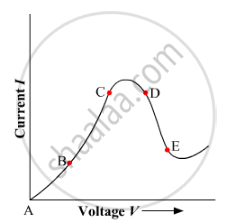Advertisements
Advertisements
Question
What is meant by resistance of a conductor ? Define its SI unit.
Solution
Resistance is the quality of a conductor that causes it to resist the flow of an electric current through it. It is the proportion of the potential difference between ends to the current flowing. It has a Sl unit of ohm (Ω).
APPEARS IN
RELATED QUESTIONS
Graph showing the variation of current versus voltage for a material Ga As is shown in the figure. Identify the region of
(i) negative resistance
(ii) where Ohm's law is obeyed.

Four resistances of 16 ohms each are connected in parallel. Four such combinations are connected in series. What is the total resistance?
State Ohm’s law and draw a neat labelled circuit diagram containing a battery, a key, a voltmeter, an ammeter, a rheostat and an unknown resistance to verify it.
A car bulb connected to a 12 volt battery draws 2 A current when glowing. What is the resistance of the filament of the bulb? Will the resistance be more same or less when the bulb is not glowing?
A wire of resistance 3 ohm and length 10 cm is stretched to length 30 cm. Assuming that it has a uniform cross section, what will be its new resistance?
- Name and state the law which relates the potential difference and current in a conductor.
- What is the necessary condition for a conductor to obey the law named above in part (a) ?
What are ohmic conductors? Give one exmaple. Draw a graph showing the current-voltage relationship for an ohmic conductor.
State macroscopic form of Ohm’s law.
Consider a current carrying wire (current I) in the shape of a circle. Note that as the current progresses along the wire, the direction of j (current density) changes in an exact manner, while the current I remain unaffected. The agent that is essentially responsible for is ______.
